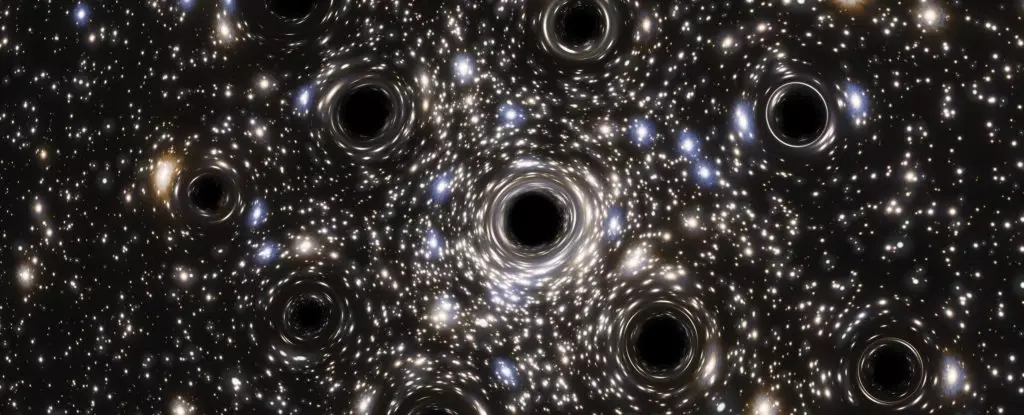Astronomy continuously presents us with dazzling spectacles, yet few phenomena capture our imagination quite like star clusters. Among these celestial wonders is the Palomar 5 globular cluster, situated approximately 80,000 light-years away from Earth. Marked by a unique distribution of stars, Palomar 5 homes a striking secret—over 100 stellar-mass black holes. Such discoveries not only add layers to our cosmic knowledge but also challenge our existing understanding of stellar evolution and cluster dynamics.
Globular clusters like Palomar 5 are often referred to as “fossils” of the early Universe. These ancient stellar groupings can harbor anywhere from 100,000 to 1 million stars, some nearly as old as the Universe itself. They are dense, spherical terrains of stellar history, where each star formed in a synchronized manner from the same primordial gas cloud. Approximately 150 globular clusters are identified within our Milky Way galaxy. These dense star formations have been utilized as windows to explore the history of the Universe and the intricacies of dark matter.
While globular clusters have long held the attention of astronomers, it is the recently identified tidal streams that have emerged as an exciting new frontier of study. Tidal streams are elongated collections of stars that drift across our sky, potentially revealing insights into the dynamic interactions within the Milky Way. Though their formation process remains a topic of debate—often thought to arise from disrupted star clusters—research using the Gaia space observatory has provided a golden opportunity to explore these structures more thoroughly.
Astrophysicists like Mark Gieles have made significant strides in this area, first recognizing that understanding tidal stream formation necessitates studying a star cluster with a known stellar connection. Among these, Palomar 5 stands as a prime candidate, acting as the Rosetta Stone for investigating star stream formation mechanisms. Featuring a vast and loosely packed star distribution, Palomar 5 presents a tantalizing puzzle, prompting thorough examination using advanced simulations.
To unravel the secrets of Palomar 5, a team of researchers employed sophisticated N-body simulations, meticulously tracking the orbits and evolutionary paths of the cluster’s stars. Their exploratory computations aimed to discern how these stars arrived at their present state. Critical to this inquiry was the consideration of black holes— specifically, the potential presence of a stellar-mass black hole population within the cluster’s center.
As the team calculated various scenarios, they discovered something striking: a significantly higher quantity of black holes than previously anticipated. These simulations revealed that the gravitational interactions within Palomar 5 could effectively launch stars out of the cluster and into the surrounding tidal stream, necessitating a black hole population approximately threefold the expectations based on the total stellar count. These black holes, roughly 20 times the mass of our Sun, originated from the remnants of massive stars dying in supernova explosions when Palomar 5 was still in its formative stages.
The findings from the simulations pointed towards a rather intriguing future: within a billion years, Palomar 5 will cease to exist as we recognize it. The cluster’s dissolution will leave behind a congregation of black holes orbiting the galactic center, further supporting the idea that globular clusters like Palomar 5 may not be unique in this fate. Other globular clusters could eventually transform into stellar streams, underscoring the transient nature of these cosmic formations.
This phenomenon raises compelling questions regarding the environments within globular clusters. Such regions are prime candidates not only for observing stellar collisions but also for hunting elusive middleweight black holes—those whose masses fall between stellar and supermassive classifications. As astrophysicist Fabio Antonini notes, binary black hole mergers are believed to frequently occur in these stellar environments. However, determining how many black holes reside within these clusters remains a daunting challenge, primarily due to the inherently elusive nature of black holes.
As we seek to grasp the complexities of our Universe, the study of Palomar 5 serves as a salient reminder of the universe’s marvels—its dynamism, transience, and the secrets hidden amongst the stars. The enduring research surrounding this stellar cluster encapsulates the ever-evolving field of astronomy, highlighting the continuous pursuit of knowledge in an ever-expanding cosmic fabric. Through ongoing explorations of tidal streams, black holes, and their interrelations, we inch closer to decoding the intricate story of our Universe, one star at a time.



Leave a Reply